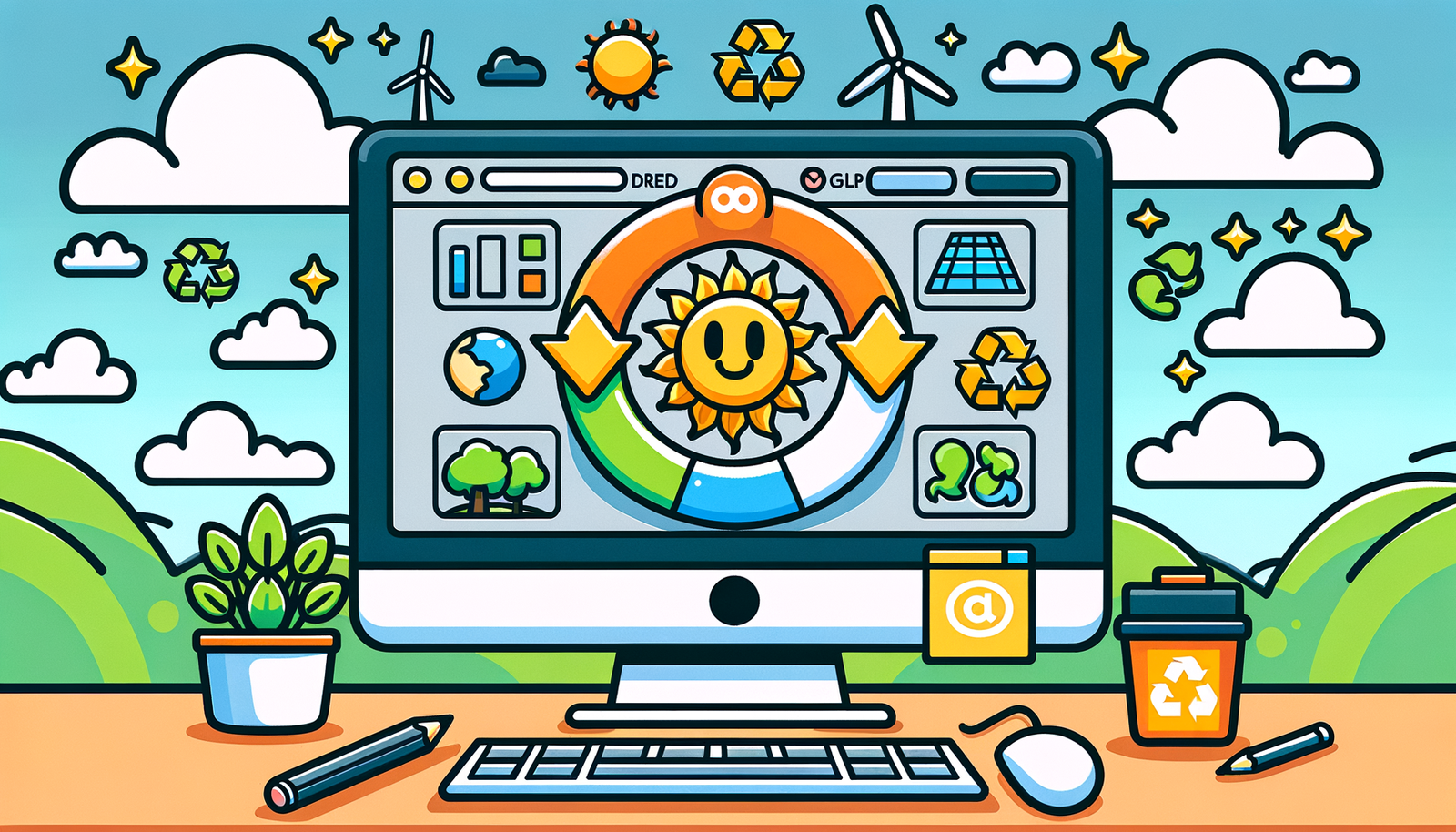Your Cart is Empty
Customer Testimonials
-
"Great customer service. The folks at Novedge were super helpful in navigating a somewhat complicated order including software upgrades and serial numbers in various stages of inactivity. They were friendly and helpful throughout the process.."
Ruben Ruckmark
"Quick & very helpful. We have been using Novedge for years and are very happy with their quick service when we need to make a purchase and excellent support resolving any issues."
Will Woodson
"Scott is the best. He reminds me about subscriptions dates, guides me in the correct direction for updates. He always responds promptly to me. He is literally the reason I continue to work with Novedge and will do so in the future."
Edward Mchugh
"Calvin Lok is “the man”. After my purchase of Sketchup 2021, he called me and provided step-by-step instructions to ease me through difficulties I was having with the setup of my new software."
Mike Borzage
Integrating Sustainability into Design Software for Long-Term Impact
February 17, 2025 12 min read


As the technology sector continues to evolve at a rapid pace, the concept of sustainability has emerged as a critical consideration in software development. The integration of sustainable practices is not just a trend but a necessity for ensuring long-term environmental, economic, and social well-being.
Definition and Core Principles
Sustainable software development refers to the process of designing, building, and deploying software in a manner that promotes long-term maintenance, efficiency, and minimal environmental impact. It encompasses various practices aimed at reducing the ecological footprint of software throughout its lifecycle, from development to disposal. At its core, sustainable software development is about creating solutions that are not only effective and efficient but also considerate of their consumption of resources and their impact on the environment.
The key principles of sustainable software development can be summarized as efficiency, longevity, and minimal environmental impact. Efficiency involves optimizing software to use the least possible amount of computational resources, such as processing power, memory, and energy. This means writing clean, optimized code that executes tasks swiftly and consumes less energy, thereby extending battery life in mobile devices and reducing electricity usage in data centers.
Longevity focuses on creating software that remains functional and relevant over an extended period. This principle discourages the throwaway culture of frequent software replacements, advocating instead for maintainable codebases, modular architectures, and the use of scalable technologies that can adapt to future needs. By extending the lifespan of software, developers can reduce the need for constant updates and replacements, thereby conserving resources.
Finally, the principle of minimal environmental impact seeks to reduce the negative effects that software can have on the environment. This includes not only the direct energy consumption of software during operation but also the indirect impacts such as the energy used during development and the electronic waste generated when hardware becomes obsolete prematurely due to software demands. By designing software that is mindful of its environmental footprint, developers contribute to a broader effort to combat climate change and promote sustainability in the tech industry.
Importance in the Modern Tech Landscape
In today's rapidly evolving technological landscape, the importance of sustainable software development cannot be overstated. As global awareness of environmental issues grows, there is increasing scrutiny on all industries to reduce their carbon footprints and contribute positively to environmental conservation efforts. The technology sector, in particular, has a significant role to play due to its pervasive influence on nearly every aspect of modern life and its substantial energy consumption.
The proliferation of data centers, cloud computing, and the Internet of Things has led to an unprecedented increase in energy use associated with digital technologies. Consequently, the growing awareness of environmental issues has propelled sustainability to the forefront of discussions in software development circles. Companies are now expected to not only deliver high-quality software solutions but also to do so in a way that is environmentally responsible.
Software has a considerable influence on energy consumption, both directly and indirectly. Directly, the efficiency of software affects how much energy is consumed during its operation. Efficient software that requires less processing power can significantly reduce energy usage, especially when deployed at scale. Indirectly, software can enable other industries to reduce their carbon footprints through optimization and automation. For instance, software that optimizes logistics can lead to reduced fuel consumption and emissions in the transportation sector.
Moreover, as consumers become more environmentally conscious, there is an increasing demand for products and services that align with sustainable practices. The tech industry is not immune to this trend, and organizations that prioritize sustainability in their software development processes can gain a competitive advantage. Embracing sustainable practices demonstrates corporate social responsibility, enhances brand image, and meets the expectations of stakeholders who value environmental stewardship.
Relevance to Design Tools
Sustainability significantly influences both the development and usage of design software tools. As powerful enablers of creativity and innovation, design tools are integral to the creation of products, buildings, and systems that shape our world. The shift towards eco-friendly design practices has placed a spotlight on the software tools used by designers, architects, and engineers, prompting a reevaluation of how these tools can support sustainable outcomes.
Design software plays a critical role in integrating sustainability into the design process. By incorporating features that allow for the analysis of environmental impacts, material selection, and energy efficiency, these tools empower professionals to make informed decisions that align with sustainable principles. For example, software that simulates energy usage in building designs enables architects to optimize structures for minimal energy consumption, thereby reducing the environmental impact over the building's lifecycle.
The shift towards eco-friendly design practices has also led software developers to consider sustainability in the development of the tools themselves. This includes optimizing the software to run efficiently on various hardware systems, reducing the computational resources required, and ensuring compatibility with devices that have longer lifespans. By doing so, design software not only aids in creating sustainable designs but also contributes to sustainability through its own operational efficiencies.
Additionally, sustainability in design tools fosters innovation by encouraging designers to explore new materials, methods, and technologies that are environmentally friendly. This can lead to the development of products and structures that are not only efficient and cost-effective but also have a reduced environmental footprint. Incorporating sustainability features into design tools thus becomes a catalyst for broader adoption of sustainable practices across industries.
Sustainable Features in Design Software
Integrating sustainable features into design software is essential for promoting eco-friendly practices in the design process. One of the primary ways this is achieved is through the implementation of energy-efficient algorithms and processes. By optimizing code and computational methods, software developers can reduce the processing power and energy required for complex design tasks. This not only lowers the environmental impact but also enhances the performance and responsiveness of the software, leading to a better user experience.
Energy-efficient algorithms can significantly reduce the time and resources needed for rendering, simulations, and other computationally intensive processes. For instance, by employing advanced data structures and algorithms that minimize redundancy and optimize calculations, design software can perform complex analyses using less energy. This is particularly important in fields like architectural design and engineering computation, where simulations can be resource-intensive.
Another critical aspect is the inclusion of tools for eco-friendly design and material optimization. Design software can provide databases of sustainable materials, along with tools to assess and compare their environmental impacts. By enabling designers to select materials based on factors like recyclability, embodied energy, and carbon footprint, the software facilitates the creation of products that are sustainable from the ground up.
Moreover, features such as life cycle assessment (LCA) tools allow designers to evaluate the environmental impact of a product throughout its entire lifespan, from raw material extraction to end-of-life disposal. By integrating these features, design software becomes a powerful ally in the pursuit of sustainability, helping professionals make data-driven decisions that align with environmental objectives.
Embedding Sustainability into Software Architecture
Embedding sustainability into the architecture of design software requires deliberate strategies and close collaboration between developers and sustainability experts. Best practices for developing sustainable design tools involve considering sustainability at every stage of the software development lifecycle. This starts with requirements gathering, where sustainability goals are defined and prioritized alongside functionality, usability, and performance objectives.
Key best practices include:
- Adopting modular and scalable architectures: Designing software that is flexible and can easily adapt to new requirements or integrate new technologies without complete redesign.
- Optimizing resource management: Ensuring efficient use of memory, computation, and data storage to reduce energy consumption and improve performance.
- Implementing efficient algorithms and code optimization: Utilizing programming techniques that minimize computational complexity and resource usage.
- Incorporating sustainability metrics: Including tools and features that measure and report on the software's environmental impact.
Collaboration between developers and sustainability experts is crucial in embedding sustainability into software architecture. Sustainability experts can provide insights into environmental impacts, energy efficiency considerations, and best practices for eco-friendly design. By working together, developers can incorporate these considerations into the software architecture, ensuring that sustainability is a foundational element rather than an afterthought.
Environmental Advantages
Sustainable software development offers significant environmental advantages, particularly in the context of design tools. One of the primary benefits is the reduction in energy consumption and resource usage. By focusing on the efficiency of software code and optimizing processes, sustainable design tools consume less electricity during operation. This is especially impactful when considering the cumulative effect of software used by large numbers of professionals worldwide.
Additionally, efficient software can extend the lifespan of hardware devices by reducing the computational load and preventing premature obsolescence. This leads to a decrease in electronic waste, as there is less need to replace devices frequently due to performance issues. By designing software that runs effectively on existing hardware, developers contribute to minimizing the environmental impact associated with the manufacturing, disposal, and recycling of electronic equipment.
The lower carbon footprint of design processes is another significant environmental advantage. Efficient design software reduces the energy required for tasks such as rendering, simulations, and data analysis. For example, in additive manufacturing, optimized software can streamline the design-to-production pipeline, reducing material waste and energy consumption during both the design and manufacturing stages. This contributes to a more sustainable production cycle and aligns with global efforts to reduce greenhouse gas emissions.
Furthermore, sustainable design tools enable professionals to create products and structures that are themselves environmentally friendly. By providing features that support the assessment and optimization of environmental impacts, these tools help designers make choices that lead to energy-efficient buildings, sustainable products, and eco-friendly infrastructure. In this way, the environmental advantages of sustainable software extend beyond the software itself to the outputs it facilitates.
Economic Benefits
Embracing sustainable software development for design tools also yields significant economic benefits. One of the most immediate advantages is cost savings from efficient software operation. Energy-efficient software reduces electricity consumption, which can lead to substantial savings, particularly for organizations that rely on high-performance computing resources or operate large data centers. Over time, these savings can offset the investments made in developing or acquiring sustainable software solutions.
Moreover, efficient software can reduce the total cost of ownership for hardware by extending its usable life. When software is optimized to run effectively on existing hardware, organizations can delay expensive upgrades and replacements. This not only reduces capital expenditures but also lowers maintenance costs associated with managing and disposing of outdated equipment.
Another economic benefit is the competitive edge in a market valuing sustainability. Companies that adopt sustainable practices can enhance their brand image and appeal to a growing segment of consumers and clients who prioritize environmental responsibility. This can open up new market opportunities, attract environmentally conscious customers, and differentiate a company's offerings from those of competitors.
Furthermore, sustainable software development can lead to innovation and improved product quality. By focusing on efficiency and optimization, developers often uncover new methods and technologies that improve overall performance. This can result in superior design tools that not only meet sustainability goals but also provide enhanced functionality and user satisfaction. The combination of cost savings, market advantages, and innovation contributes to a strong business case for investing in sustainable software development.
Enhanced User Experience and Social Responsibility
Beyond environmental and economic benefits, sustainable software development enhances user experience and promotes social responsibility. Improved performance and reliability are direct outcomes of efficient software. Users benefit from faster processing times, reduced lag, and smoother operation, which can significantly improve productivity, especially in professional settings where design tools are critical for daily tasks.
Sustainable software is often more stable and has fewer errors due to the rigorous optimization processes involved in its development. This leads to a more reliable user experience, reducing frustration and downtime caused by software glitches or crashes. In turn, this can increase user satisfaction and loyalty, as professionals prefer tools that enable them to work efficiently and effectively.
Building trust and loyalty through responsible practices is an important aspect of social responsibility. By prioritizing sustainability, companies demonstrate a commitment to the well-being of the environment and society at large. This resonates with users who value ethical practices and can lead to stronger relationships between companies and their customers. In an age where corporate values play a significant role in consumer decisions, demonstrating social responsibility can be a powerful differentiator.
Additionally, sustainable software development contributes to a culture of environmental stewardship within organizations. It encourages employees to adopt eco-friendly practices and promotes awareness of sustainability issues. This can enhance employee engagement and attract talent who are passionate about making a positive impact through their work. The combined effect of enhanced user experience and social responsibility reinforces the importance of sustainability in software development.
Technical and Practical Obstacles
Despite the clear benefits, integrating sustainability into software development for design tools presents several technical and practical challenges. One of the primary obstacles is balancing sustainability with functionality and performance. Developers may face difficulties ensuring that optimized, energy-efficient software also meets the high-performance demands of complex design tasks. Striking this balance requires careful planning, advanced technical expertise, and often, innovative solutions to avoid compromising on features or user experience.
Key obstacles include:
- Resistance to change: Overcoming reluctance within the industry to adopt new sustainable practices and transition away from established systems.
- Lack of awareness: Addressing insufficient knowledge of sustainability issues among developers and stakeholders, which can hinder prioritization of sustainable practices.
- Technical limitations: Dealing with constraints imposed by existing hardware, infrastructure, and the availability of advanced tools required for optimization.
- Resource constraints: Allocating time and funding for research and development focused on sustainability can be challenging in resource-limited environments.
Technical limitations can also impede the integration of sustainability. For instance, optimizing software for energy efficiency may require advanced algorithms or new programming paradigms that are not widely adopted or understood. There may be limitations in tools and resources available to developers, or constraints imposed by existing hardware and infrastructure. Addressing these obstacles requires investment in research and development, as well as collaboration across the industry to share knowledge and best practices.
Industry Adoption and Standards
The advancement of sustainability in design software depends heavily on industry adoption and the establishment of universal standards. The need for universal sustainability standards in design software is critical to ensure that efforts are consistent, measurable, and effective across different organizations and platforms. Standards provide a framework for developers to follow, making it easier to integrate sustainability into software development processes systematically.
Establishing such standards involves defining metrics for energy efficiency, resource utilization, and environmental impact that are applicable to software tools. These metrics enable the benchmarking of software sustainability and facilitate comparisons between different tools. By adhering to common standards, developers can ensure that their software meets accepted levels of environmental performance, thereby promoting transparency and accountability.
Encouraging widespread adoption of sustainable practices can be achieved through incentives and regulations. Governments and industry bodies can play a significant role by providing incentives such as tax benefits, grants, or recognition programs for companies that demonstrate leadership in sustainable software development. Regulations may include mandates for energy efficiency in software or requirements for reporting environmental performance.
Collaboration among stakeholders is essential for establishing and promoting industry standards. This includes developers, companies, industry associations, academia, and sustainability experts working together to develop guidelines, share knowledge, and drive innovation. Open-source initiatives and collaborative platforms can facilitate this process, enabling a collective effort towards sustainability goals.
Future Trends in Sustainable Design Software
Looking ahead, several innovations are poised to drive sustainability in design tools. Emerging technologies like artificial intelligence (AI) and machine learning offer significant potential for enhancing the efficiency and capabilities of design software. AI can optimize algorithms and processes beyond what is achievable through traditional programming, leading to greater energy efficiency and performance.
The role of AI and machine learning extends to enabling more advanced simulations and predictive analytics that can inform sustainable design decisions. For example, AI-driven tools can analyze vast datasets to identify patterns and recommend design optimizations that reduce environmental impacts. This can lead to the development of smarter, more efficient products and structures.
Another future trend is the increasing integration of cloud computing and edge computing in design software. Cloud-based platforms can offer scalable resources that are managed more efficiently, potentially reducing overall energy consumption. Edge computing can distribute computational load, minimizing the need for data transfer and associated energy use.
Innovations in user interfaces and experience design are also expected to contribute to sustainability. By creating more intuitive and efficient interfaces, designers can reduce the time and resources required to complete tasks. Additionally, the adoption of virtual and augmented reality technologies may enhance the ability to visualize and assess designs in ways that support sustainable outcomes.
Finally, as sustainability becomes more deeply ingrained in corporate and societal values, it is likely that sustainable design software will become the norm rather than the exception. This cultural shift will drive further investment in sustainable technologies and practices, leading to continuous improvements and new breakthroughs in the field.
Summary of Key Points
In conclusion, sustainable software development plays a pivotal role in shaping the future of design tools. By embracing key principles such as efficiency, longevity, and minimal environmental impact, developers and organizations can create software that not only meets the functional needs of users but also contributes positively to environmental conservation efforts. The integration of sustainability into design tools enhances environmental advantages by reducing energy consumption and lowering carbon footprints. It also offers economic benefits through cost savings and provides a competitive edge in a market that values environmental responsibility.
The Path Forward
Encouraging the continued integration of sustainability in software design requires collective action from developers, companies, and industry stakeholders. Embracing best practices, adopting industry standards, and fostering collaboration are essential steps towards this goal. By investing in education, innovation, and policy advocacy, the tech industry can overcome challenges and drive the widespread adoption of sustainable software development practices. The commitment to sustainability must be sustained and amplified to ensure that the benefits are realized across environmental, economic, and social dimensions.
Final Thoughts
The long-term benefits of prioritizing sustainability in software development are profound. For the environment, it means a significant reduction in energy consumption, resource use, and greenhouse gas emissions. Economically, it leads to cost savings, innovation, and competitive advantages. Socially, it enhances user experiences, builds trust, and fulfills a corporate responsibility towards society. As we move forward, it is imperative for designers, developers, and stakeholders to place sustainability at the forefront of their priorities. Together, we can shape a future where technology and environmental stewardship go hand in hand, creating a better world for generations to come.
Also in Design News

2D/3D Animation:Collaboratory with Mike Morris and Aaron Paetz
February 20, 2025 1 min read
Read More
ZBrush Tip: Enhancing Organic Sculpting Techniques in ZBrush: Key Tips and Resources
February 20, 2025 2 min read
Read More
Revit Tip: Mastering Revit's Edit Profile Tool for Customized Design Efficiency
February 20, 2025 2 min read
Read MoreSubscribe
Sign up to get the latest on sales, new releases and more …


